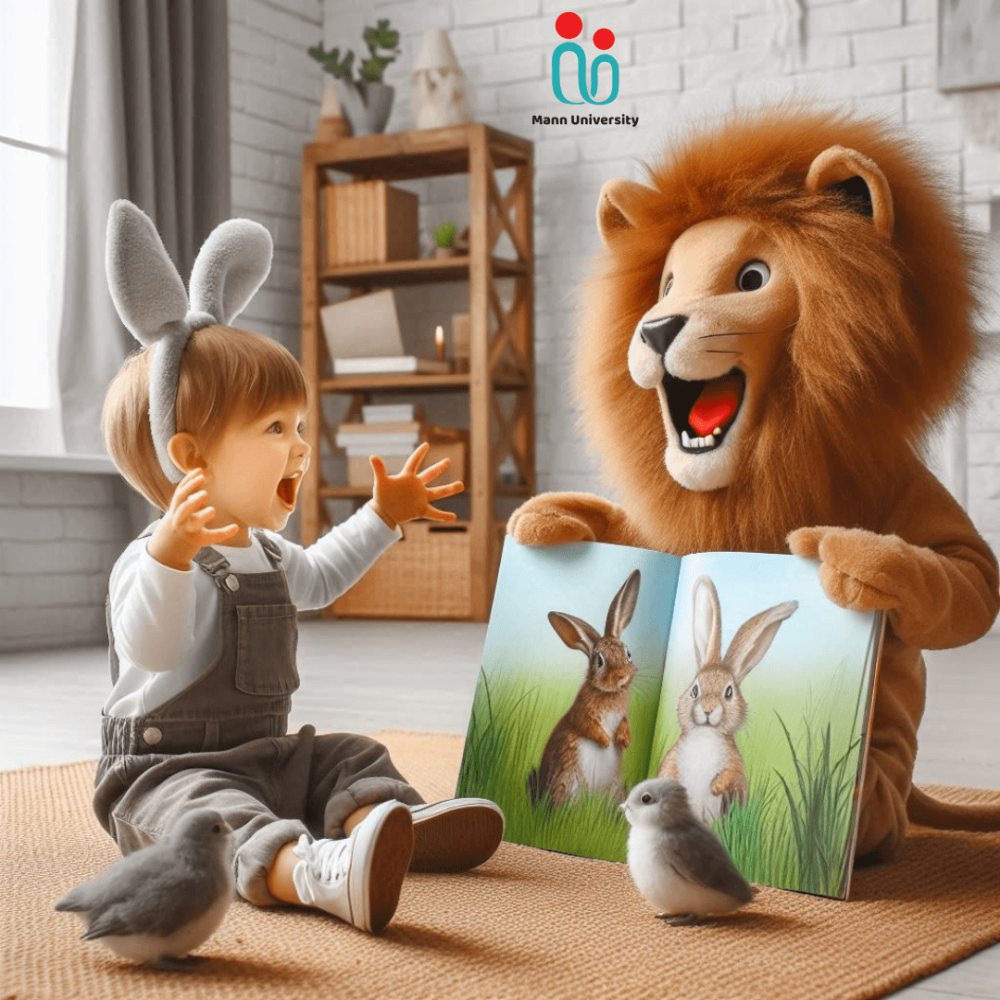Lion's Pride, Rabbit's Wisdom interactive storytelling and dramatic play activity explores the concepts of pride and humility through the classic fable of the Lion and the Rabbit. It encourages emotional understanding, language development, and social interaction in toddlers.
Emotional (EQ): "Proud Lion, Humble Rabbit" - Discuss how being too proud can be a problem (like the lion). Show pictures representing pride and humility.

Appropriate Age: 18-24 months (specifically includes 20 months)
Objective:
Materials:
How to do this activity (Step-by-step Process):
Introduction (5 minutes): Gather your child and introduce the characters. Show the pictures of the lion and the rabbit. Use simple language to describe their personalities. “Look, this is a strong lion! He’s very proud. And this is a clever rabbit. He’s kind and helpful.”
Storytelling (10 minutes): Tell the story of the Lion and the Rabbit. You can use a storybook, act it out with the props, or simply narrate it. Emphasize the lion’s pride and the rabbit’s humility and cleverness. Use expressive voices and gestures to bring the story to life.
Dramatic Play (15 minutes): Encourage your child to participate in acting out the story. “Can you roar like the proud lion? Now, can you hop like the clever rabbit?” Guide them through the different scenes, such as the lion chasing the rabbit or the rabbit tricking the lion at the well.
Discussion (5 minutes): After the play, talk about the story. Ask simple questions: “How did the lion feel when he was chasing the rabbit? How did the rabbit feel?” Reinforce the concepts of pride and humility. “The lion was too proud, and that caused him problems. The rabbit was humble and clever.”
Wrap-up (5 minutes): End the activity with a song or a gentle cuddle. Praise your child’s participation and effort.
“Play is the highest form of research.” – Albert Einstein. This quote highlights the importance of play-based learning for toddlers. Dramatic play allows children to explore different roles and emotions, fostering their social and emotional development.
Fables like “The Lion and the Rabbit” have been passed down through generations, serving as a way to teach moral lessons through engaging stories. These stories often use animal characters to represent human traits and behaviors.
Some might think that playing pretend is just a frivolous activity. However, research clearly demonstrates its crucial role in cognitive, social, and emotional development.
URL: https://www.zerotothree.org/
URL: https://www.cdc.gov/ncbddd/childdevelopment/index.html
“Lion’s Pride, Rabbit’s Wisdom” offers a fun and engaging way to introduce toddlers to important social-emotional concepts. Through storytelling and dramatic play, children can learn about pride, humility, and the importance of kindness. This activity also supports language development, fosters creativity, and enhances gross motor skills.
Try this activity with your little one and watch their imagination soar! Embrace the power of play and create lasting memories while nurturing their development.
Let’s Play!
Share your experience in the comments! We’d love to hear how this activity worked for you and your child.
Dr.Bhavin Dhamsaniya (BHMS, MD Homeopathy Psychiatry, DNYS)

Dr. Bhavin Dhamsaniya is a homeopathic physician with an M.D. in Homeopathic Psychiatry. As the founder of Mann University, he specializes in the holistic connection between a child’s mind, emotions, and development. His “Parent’s Gardener” philosophy guides parents to nurture their child’s innate curiosity through mindful, play-based connection. Learn more about Dr. Dhamsaniya here…
Not a member yet? Register now
Are you a member? Login now